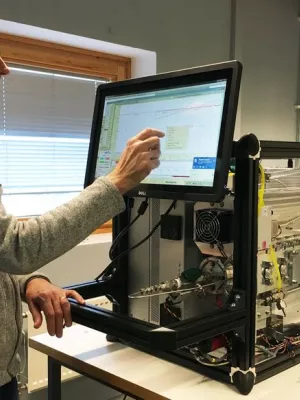
Erik Swietlicki
Professor

Carbonaceous aerosol source apportionment using the Aethalometer model -evaluation by radiocarbon and levoglucosan analysis at a rural background site in southern Sweden
Author
Summary, in English
With the present demand on fast and inexpensive aerosol source apportionment methods, the Aethalometer model was evaluated for a full seasonal cycle (June 2014–June 2015) at a rural atmospheric measurement station in southern Sweden by using radiocarbon and levoglucosan measurements. By utilizing differences in absorption of UV and IR, the Aethalometer model apportions carbon mass into wood burning (WB) and fossil fuel combustion (FF) aerosol. In this study, a small modification in the model in conjunction with carbon measurements from thermal–optical analysis allowed apportioned non-light-absorbing biogenic aerosol to vary in time. The absorption differences between WB and FF can be quantified by the absorption Ångström exponent (AAE). In this study AAEWB was set to 1.81 and AAEFF to 1.0. Our observations show that the AAE was elevated during winter (1.36 ± 0.07) compared to summer (1.12 ± 0.07). Quantified WB aerosol showed good agreement with levoglucosan concentrations, both in terms of correlation (R2 = 0. 70) and in comparison to reference emission inventories. WB aerosol showed strong seasonal variation with high concentrations during winter (0.65 µg m−3, 56 % of total carbon) and low concentrations during summer (0.07 µg m−3, 6 % of total carbon). FF aerosol showed less seasonal dependence; however, black carbon (BC) FF showed clear diurnal patterns corresponding to traffic rush hour peaks. The presumed non-light-absorbing biogenic carbonaceous aerosol concentration was high during summer (1.04 µg m−3, 72 % of total carbon) and low during winter (0.13 µg m−3, 8 % of total carbon). Aethalometer model results were further compared to radiocarbon and levoglucosan source apportionment results. The comparison showed good agreement for apportioned mass of WB and biogenic carbonaceous aerosol, but discrepancies were found for FF aerosol mass. The Aethalometer model overestimated FF aerosol mass by a factor of 1.3 compared to radiocarbon and levoglucosan source apportionment. A performed sensitivity analysis suggests that this discrepancy can be explained by interference of non-light-absorbing biogenic carbon during winter. In summary, the Aethalometer model offers a cost-effective yet robust high-time-resolution source apportionment at rural background stations compared to a radiocarbon and levoglucosan alternative.
Department/s
- Nuclear physics
- Centre for Environmental and Climate Science (CEC)
- Centre for Analysis and Synthesis
- MERGE: ModElling the Regional and Global Earth system
- Consortium for Aerosol Science and Technology at Lund University (CAST)
- Faculty of Engineering, LTH
Publishing year
2017
Language
English
Pages
4265-4281
Publication/Series
Atmospheric Chemistry and Physics
Volume
17
Document type
Journal article
Publisher
Copernicus GmbH
Topic
- Meteorology and Atmospheric Sciences
Status
Published
ISBN/ISSN/Other
- ISSN: 1680-7324